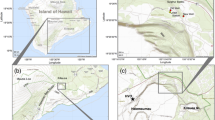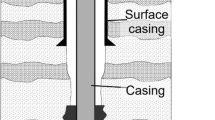Abstract
Helium (He) concentration and 3He/4He anomalies in soil gas and spring water are potentially powerful tools for investigating hydrothermal circulation associated with volcanism and could perhaps serve as part of a hazards warning system. However, in operational practice, He and other gases are often sampled only after volcanic unrest is detected by other means. A new passive diffusion sampler suite, intended to be collected after the onset of unrest, has been developed and tested as a relatively low-cost method of determining He-isotope composition pre- and post-unrest. The samplers, each with a distinct equilibration time, passively record He concentration and isotope ratio in springs and soil gas. Once collected and analyzed, the He concentrations in the samplers are used to deconvolve the time history of the He concentration and the 3He/4He ratio at the collection site. The current suite consisting of three samplers is sufficient to deconvolve both the magnitude and the timing of a step change in in situ concentration if the suite is collected within 100 h of the change. The effects of temperature and prolonged deployment on the suite’s capability of recording He anomalies have also been evaluated. The suite has captured a significant 3He/4He soil gas anomaly at Horseshoe Lake near Mammoth Lakes, California. The passive diffusion sampler suite appears to be an accurate and affordable alternative for determining He anomalies associated with volcanic unrest.











Similar content being viewed by others

References
Andrews J (1985) The isotopic composition of radiogenic helium and its use to study groundwater movement in confined aquifers. Chem Geol 49(1):339–351
Brown R, Charlton J, Saunders K (1981) The development of an improved diffusive sampler. Am Ind Hyg Assoc J 42(12):865–869
Carapezza ML, Inguaggiato S, Brusca L, Longo M (2004) Geochemical precursors of the activity of an open-conduit volcano: the Stromboli 2002–2003 eruptive events. Geophys Res Lett 31(7), L07620
Clarke WB, Beg M, Craig H (1969) Excess 3He in the sea: evidence for terrestrial primodal helium. Earth Planet Sci Lett 6(3):213–220
Craig H, Lupton J, Welhan J, Poreda R (1978) Helium isotope ratios in Yellowstone and Lassen Park volcanic gases. Geophys Res Lett 5(11):897–900
Crank J (1975) The mathematics of diffusion. Clarendon, Oxford
Evans WC, Sorey ML, Cook AC, Kennedy BM, Shuster DL, Colvard EM, White LD, Huebner MA (2002) Tracing and quantifying magmatic carbon discharge in cold groundwaters: lessons learned from Mammoth Mountain, USA. J Volcanol Geotherm Res 114(3–4):291–312
Evans WC, van Soest MC, Mariner RH, Hurwitz S, Ingebritsen SE, Wicks CW, Schmidt ME (2004) Magmatic intrusion west of Three Sisters, central Oregon, USA: the perspective from spring geochemistry. Geology 32(1):69–72
Gardner P, Solomon DK (2009) An advanced passive diffusion sampler for the determination of dissolved gas concentrations. Water Resour Res 45(6), W06423
Gardner WP, Susong DD, Solomon DK, Heasler HP (2010) Using noble gases measured in spring discharge to trace hydrothermal processes in the Norris Geyser Basin, Yellowstone National Park, U.S.A. J Volcanol Geotherm Res 198(3–4):394–404
Gascoyne M, Sheppard MI (1993) Evidence of terrestrial discharge of deep groundwater on the Canadian Shield from helium in soil gases. Environ Sci Technol 27(12):2420–2426
Hilton DR (1996) The helium and carbon isotope systematics of a continental geothermal system: results from monitoring studies at Long Valley caldera (California, U.S.A.). Chem Geol 127(4):269–295
Ingebritsen SE et al (2014) Hydrothermal monitoring in a quiescent volcanic arc: Cascade Range, northwestern United States. Geofluids 14:326–346. doi:10.1111/gfl.12079
Jacinthe PA, Groffman PM (2001) Silicone rubber sampler to measure dissolved gases in saturated soils and waters. Soil Biol Biochem 33(7–8):907–912
Kot A, Zabiegała B, Namieśnik J (2000) Passive sampling for long-term monitoring of organic pollutants in water. TrAC Trends Anal Chem 19(7):446–459
Krämer H, Conrad R (1993) Measurement of dissolved H < sub > 2</sub > concentrations in methanogenic environments with a gas diffusion probe. FEMS Microbiol Ecol 12(3):149–158
Lewicki JL, Hilley GE (2014) Multi-scale observations of the variability of magma CO2 emissions, Mammoth Mountain, CA, USA. J Volcanol Geotherm Res 284:1–15
Lupton JE, Craig H (1981) A major helium-3 source at 15 S on the East Pacific Rise. Science 214(4516):13–18
Lupton J, Weiss R, Craig H (1977) Mantle helium in hydrothermal plumes in the Galapagos Rift. Nature 267:603–604
McGee KA, Gerlach TM, Kessler R, Doukas MP (2000) Geochemical evidence for a magmatic CO2 degassing event at Mammoth Mountain, California, September-December 1997. J Geophys Res 105(B4):8447–8456
Ozima M, Podosek FA (1983) Noble gas geochemistry, Cambridge University Press
Padrón E et al (2013) Diffusive helium emissions as a precursory sign of volcanic unrest. Geology 41(5):539–542
Ryan WBF, Carbotte SM, CoplanJO, O'Hara S, Melkonian A, Arko R, Weissel RA, Ferrini V, Goodwillie A, Nitsche F, Bonczkowski J, Zemsky R (2009) Global multi-resolution topography synthesis. Geochem Geophys Geosyst 10(3)
Sanford WE, Shropshire RG, Solomon DK (1996) Dissolved gas tracers in groundwater: simplified injection, sampling, and analysis. Water Resour Res 32(6):1635–1642
Sano Y, Wakita, H (1985) Geographical distribution of 3He/4He Ratios in Japan: implications for arc tectonics and incipient magmatism, J Geophys Res 90(B10):8729–8741
Sano Y, Nakamura Y, Notsu K, Wakita H (1988) Influence of volcanic eruptions on helium isotope ratios in hydrothermal systems induced by volcanic eruptions. Geochim Cosmochim Acta 52(5):1305–1308
Sano Y, Sano K, Notsu JI, Ishibashi G, Igarashi H, Wakita (1991) Secular variations in helium isotope ratios in an active volcano: eruption and plug hypothesis. Earth Planet Sci Lett 107(1):95–100
Sheldon AL (2002) Diffusion of radiogenic helium in shallow groundwater: implications for crustal degassing, Ph.D. thesis, 171–171 p. pp, The University of Utah, Ann Arbor
Solomon DK (2000) 4He in groundwater, in Environmental tracers in subsurface hydrology, edited, pp. 425–439, Springer
Sorey ML, Kennedy BM, Evans WC, Farrar CD, Suemnicht GA (1993) Helium isotope and gas discharge variations associated with crustal unrest in Long Valley Caldera, California, 1989–1992. J Geophys Res Solid Earth 98(B9):15871–15889
Sorey ML, Evans WC, Kennedy BM, Farrar CD, Hainsworth LJ, Hausback B (1998) Carbon dioxide and helium emissions from a reservoir of magmatic gas beneath Mammoth Mountain, California. J Geophys Res Solid Earth 103(B7):15303–15323
Stuer-Lauridsen F (2005) Review of passive accumulation devices for monitoring organic micropollutants in the aquatic environment. Environ Pollut 136(3):503–524
Torgersen T, Clarke W (1985) Helium accumulation in groundwater, I: an evaluation of sources and the continental flux of crustal 4He in the Great Artesian Basin, Australia. Geochim Cosmochim Acta 49(5):1211–1218
Werner C, Bergfeld D, Farrar CD, Doukas MP, Kelly PJ, Kern C (2014) Decadal-scale variability of diffuse CO2 emissions and seismicity revealed from long-term monitoring (1995–2013) at Mammoth Mountain, California, USA. J Volcanol Geotherm Res 289:51–63
Wicks CW, Dzurisin D, Ingebritsen S, Thatcher W, Lu Z, Iverson J (2002) Magmatic activity beneath the quiescent Three Sisters volcanic center, central Oregon Cascade Range, USA. Geophys Res Lett 29(7), 26-21-26-24
Zhdanov MS (2002) Methods in geochemistry and geophysics, Elsevier
Acknowledgments
This project has been funded jointly by the Volcano Hazards and National Research Programs of the USGS and the University of Utah. Special thanks and acknowledgement go to Alan Rigby and Wil Mace of the University of Utah Noble Gas Lab. The manuscript was greatly improved with the help of Cynthia Werner and the two anonymous journal reviewers.
Author information
Authors and Affiliations
Corresponding author
Additional information
Editorial responsibility: G. Giordano
Rights and permissions
About this article
Cite this article
Dame, B.E., Solomon, D.K., Evans, W.C. et al. Developing a new, passive diffusion sampler suite to detect helium anomalies associated with volcanic unrest. Bull Volcanol 77, 23 (2015). https://doi.org/10.1007/s00445-015-0912-4
Received:
Accepted:
Published:
DOI: https://doi.org/10.1007/s00445-015-0912-4



